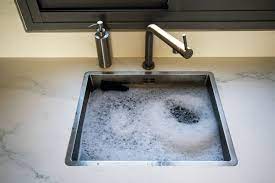Overflow holes are an essential part of any bathroom sink, as they prevent water from spilling over the sink rim and onto the countertop. However, over time, these holes can become clogged with dirt, debris, and mineral buildup, leading to stagnant water and unpleasant odors. Cleaning overflow holes in your bathroom sink is an easy and essential part of your bathroom maintenance routine. Here’s a step-by-step guide on how to clean overflow holes in your bathroom sink.
Gather Supplies
To clean the overflow holes in your bathroom sink, you’ll need a few supplies:
Rubber gloves to protect your hands
White vinegar or hydrogen peroxide
Baking soda
An old toothbrush or small scrub brush
A small funnel or turkey baster
Clean cloth or sponge
Bucket or bowl
Clear the Sink
Before you begin cleaning the overflow holes, clear out any items in your sink, such as soap dishes or toothbrush holders. This will give you more space to work and prevent any items from getting in the way.
Mix the Cleaning Solution
Next, mix the cleaning solution. There are a few options you can use:
White vinegar: Mix equal parts white vinegar and water in a bowl or bucket. The vinegar will help dissolve mineral buildup and disinfect the area.
Hydrogen peroxide: Mix equal parts hydrogen peroxide and water in a bowl or bucket. Hydrogen peroxide is a natural disinfectant that can help remove dirt and stains.
Baking soda: Mix baking soda with enough water to form a paste. Baking soda is a mild abrasive that can help remove stains and buildup.
Apply the Cleaning Solution
Apply the cleaning solution to the overflow holes. You can use a small funnel or turkey baster to pour the solution into the holes. Allow the solution to sit for a few minutes to dissolve any buildup and disinfect the area.
Scrub the Overflow Holes
Using an old toothbrush or small scrub brush, scrub the overflow holes thoroughly. Use gentle pressure and circular motions to remove any dirt, debris, or mineral buildup. You may need to repeat this step a few times to completely remove all the buildup.
Rinse with Water
Once you’ve scrubbed the overflow holes, rinse them thoroughly with water. You can use the sink faucet to rinse them or fill a bucket or bowl with water and pour it over the holes. Make sure all the cleaning solution and debris have been flushed out.
Wipe Dry
Finally, wipe the overflow holes and the surrounding area dry with a clean cloth or sponge. This will help prevent any water spots or stains from forming.
Repeat as Needed
If the overflow holes are heavily clogged, you may need to repeat this process a few times to completely clear them. You can also use a small pipe cleaner or toothpick to remove any stubborn debris that is difficult to remove with a brush.
In conclusion, cleaning the overflow holes in your bathroom sink is an important part of your bathroom maintenance routine. By following these steps, you can ensure that your sink is free of debris and buildup and prevent any unpleasant odors from forming. Regular cleaning of the overflow holes will also help maintain the overall cleanliness of your bathroom sink.

